|

The Newcastle
Chinatown
Graphic
reproduced courtesy of Chinatown Online




As a "guest" overseas, my mind is in
the motherland and our remote origin,
Making my home globally, I hold hands with new
friends
to keep our heritage for generations to come.
| |
Copyright
|
|
All rights reserved. No part of this publication may be used
without the permission of The Tyne & Wear Enterprise Trust Ltd.
|
CONTENTS
|
|
1.
Introduction
|
|
1.1
The Grainger Town
Partnership
|
|
1.2
Ethnic Business
Development
|
|
1.3
Community Skills Audit
|
|
1.4
Aims and Objectives of the Community Skills Audit
|
|
1.5
Methodology
|
|
1.5.1
The profile of the sample
|
|
2.
Overview
|
|
2.1 Section 3 Education
|
|
2.2 Section 4 Training
|
|
2.3 Section 5 Employment
|
|
2.4 Section 6 Unemployment
|
|
2.5 Section Self-employed
|
|
2.6
Section 8 Skills
|
|
3. Funders
|
Single Regeneration Budget
As part of the Grainger Town Partnership
(Newcastle City Council)
European Regional Development Fund
|
Project Management
|
|
Tony Yau
|
|
Author
|
|
Carol Mcleod
|
|
Researchers
|
|
Tu Nham Mao
|
|
Katty Law
|
Amanda Chan
|
|
Sandra Yau
|
|
Hazel Tang
|
|
Sharon Zho
|
|
Yuan Tzan
|
|
Hint Chau
|
|
Data Input
|
|
Joanne Ord
|
|
Database Design
|
|
Emma
|
|
The views expressed within this report are not intended to
reflect those of the project funders.
|
|
1 Introduction
|
|
1.1 The Grainger Town Partnership
|
|
The Grainger Town Partnership is a Single Regeneration Budget
partnership comprising of a number of voluntary, statutory, community and
business organisations active within the Grainger Town Area.1
|
|
As part of the Grainger Town Partnership ENTRUST has been
granted approval for an initiative entitled 'Ethnic Business Development'.
|
|
1.2 Ethnic Business Development
|
|
This initiative aims to utilise the specialist expertise,
which ENTRUST2 has, in development work with SMEs and
underrepresented groups. In particular the project aims to assist the economic
regeneration of the Grainger Town area by assisting the Chinese community and
business community clustered around Stowell Street, in the area generally known
as Chinatown.
|
|
The emphasis of this initiative will be on diversification
into non- traditional areas. Currently the Chinese business community is too
highly concentrated in catering, which leaves them in a vulnerable position.
Whilst vertical diversification has occurred, horizontal diversification needs
to be encouraged. The initiative would concentrate on the second generation, the
unemployed, the under-employed within the Chinese community.
|
|
In undertaking such an initiative it is necessary to have a
clear understanding of the structure of the community.
|
|
1.3 Community Skills Audit
|
|
A Community Skills Audit was chosen as the initial
contact with the community to establish a clear understanding of the dynamics of
the community as a whole; its business leaders; its small businesses; its
individuals; its aims, aspirations and objectives; its groups and its skills.
|
|
ENTRUST would then use the audit as a base for the
following activities:
|
- One to one counselling, advice and signposting over an
extended period of time for individuals and businesses.
- Business needs analysis
- Identifying other diversification mechanisms through market
research
- Diversification, either through new markets or promoting the use of IT and
the Internet for marketing or enhancing owner/manager competencies.
- Using the financial resources of the Chinese community to assist
diversification through investment: accessing equity and loan finance from
the ENTRUST 'Business Angels' scheme and loan funds.
|
|
This report sets out the Community Skills Audit that was
undertaken and the analysis of the findings.
|
|
1.4 Aims and Objectives of the Community Skills Audit
|
|
At its inception the stated objectives of the Community
Skills Audit were to: -
|
- Identify the education, training and employment of the Chinese community
of the Stowell Street, Bath Lane and other relevant areas.
- Identify underemployment within the sample.
- Identify the perceived barriers to gaining employment that the community
faces.
- Determine the employment and training aspirations of the Chinese
community.
- Determine the self-employed's aspirations within the community and the
aspirations of others to venture into business.
|
|
1.5 Methodology
|
|
The aim of this survey was to be more than a simple audit of
the existing skills within the Chinese community. It is the intention of this
report to provide data and raise awareness of issues relating to the economic
development of the community.
The survey therefore examines a number of varied issues in
relation to the existing skill base, which are relevant to the personal
aspirations of individuals.
The report has a sample of 84 respondents from the age of
sixteen, across the geographical range of the North East of England, but
centrally Newcastle upon Tyne. 7 researchers chose from the area in and around
the Grainger Town, where they were located. Chinese researchers were
specifically employed and trained for the survey due to the specialist area of
the audit.
Each interview had a structure set around a specifically
designed questionnaire. The questionnaire was given a serial number for future
reference and each individual questionnaire was recorded using this process for
confidentiality.
Confidentiality was of the utmost importance throughout and
each individual signed the Data Protection Act of 1984 to ensure that it was
carried throughout the whole recording processes.
The questionnaire encompassed questions on Education,
Training, Unemployment, Self-employment and Aspirations.
The interviews were chosen as the most effective method due
to the efficiency and accuracy by which information could be recorded. As well
as the time and costs which were all kept to a minimum with this process.
A copy of the questionnaire can be found in the appendices3.
|
|
1.5.1 The Profile of the Sample:
|
|
Sample size: 84
|
|
Chart 1: Age of the sample.
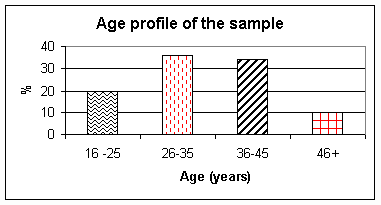
|
|
The respondents were mostly between the ages of 26 and 45.
This age range is what is considered to be the second generation of the
community, which in terms of the audit was what was being looked for exactly, as
mentioned previously in this methodology.
|
|
Chart 2: Gender profile of the sample
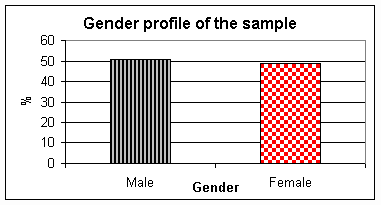
|
|
The gender profile although as random as the rest of the
sample, did provide a near exact divide between the genders, 51% male and 49%
female, which in terms of equal opportunities gave the audit a clear head start.
|
|
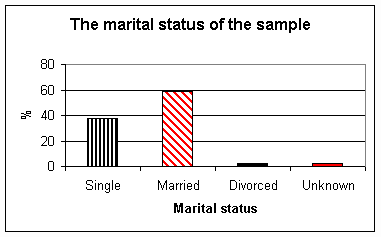
Chart 3: The marital
status of the sample
|
|
A considerable number (60%) of respondents were married and a
fairly large number (39%) also considered themselves to be single.
|
|
Chart 4: Place of Birth
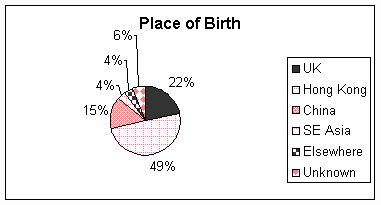
|
|
Chart 5: UK residency if born outside the UK
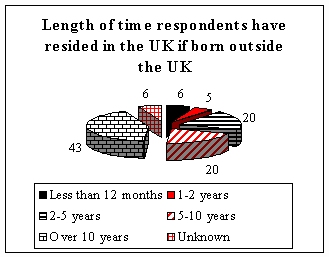
|
|
A significant percentage of respondents had lived for over 10
years in the UK. Only 6% of respondents had resided in the UK for less than 12
months.
|
|
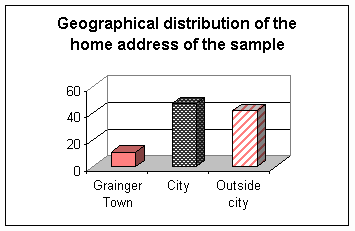
Chart 6: Geographical distribution of the home address of
the sample.
|
|
41% of the sample lived within the City boundaries of
Newcastle upon Tyne. A further 10% lived within the Grainger Town area.
|
|
2.0 Overview
|
|
This analysis draws together
the principal elements from the sections within the main report and aggregates
the key data.
|
|
2.1 Section 3 Education
|
|
A key element in the economic development of any community is
the level of educational attainment of its individuals.
|
- 27% of respondents had no formal education.
- 48% of respondents attended school within the UK.
- 31% of respondents had A-Level qualifications from the UK.
- 25% of respondents had attained a degree level subject.
|
|
Generally respondents attained a high level of education.
|
|
Significantly a high level of unemployed respondents had some
form of higher education qualification.
|
|
2.2 Section 4 Training
|
|
Training like education is a key element in the economic and
personal development of any community.
|
- 48% of the total sample indicated their desire to attend further training
courses in the future.
- A varied interest in other courses was also expressed such as 'Tax',
'English' and 'Buying'.
- The most in demand courses were IT 40%, Importing/ Exporting 37% and
raising money 36%, however all suggested courses aggregated a high number of
interest.
- 40% of respondents believed their present job did not match their skills
and training.
- The largest group of unemployed respondents only had 'on the job'
training.
- Only 12% of self employed respondents provided training within their own
business.
- 71% of self-employed respondents were interested in training courses.
- 79% of respondents would take up free advice, training and finance to set
up in business.
- The most significant barrier all respondents believed prevented
them from undertaking training was perceived to be free time at 25% and
unsuitable times of courses 19%.
|
|
2.3 Section 5 Employment
|
- 42% of respondents were in employment, this figure does not include the
25% of respondents who were self- employed.
- 40% of those employed worked within the Grainger Town area.
- 79% of respondents held valid driving licences
- 40 % of employed persons gained employment by approaching their employer
directly.
- Only 3% of respondents obtained employment from a job centre.
- 38% of respondents were employed in the catering industry.
- 53% of respondents had always been employed in the same job.
- 39% of respondents were employed within small companies with 1 to 9
employees.
- 41% of respondents believed their present job did not match their personal
skills and training.
- 'Lack of job satisfaction' and ' not the first career
choice' was among
the various reasons given for wanting another position.
- 32% of respondents were looking for another position of employment.
|
|
2.4 Section 6 Unemployment
|
- 34% of respondents were unemployed.
- 40% of respondents had been ?out of work? for over 12 months.
- 48% of respondents highlighted travel as their main problem in obtaining a
job.
- 33% stated they did not have any problems in obtaining a job.
- A high number of respondents had been previously employed within the
catering industry.
- 'Customer relations', 'team management' and 'marketing' were only a few of
the skills the respondents felt they had.
- 42% of respondents wanted to go back to 'full-time' work.
- 39% of respondents were interested in training courses.
- 50% of respondents were not claiming any form of benefit.
- 60% of respondents gave their reason for unemployment as personal.
|
|
2.5 Section 7 Self - Employed
|
- 25% of all respondents were self-employed.
- 31% of respondents businesses were located in the Grainger Town area.
- 17% of respondents had a restaurant / food business.
- 25% of respondents had been in business for over 10 years.
- 51% of respondents had always been self- employed.
- 48% of businesses were family owned.
- 80% of businesses employed 1 to 5 employees.
- 55% of businesses were sole- traders.
- 33% of businesses had assistance to set up in business from a bank, whilst
27% had assistance from family & friends.
- Respondents indicated some form of business aspirations such as
'increase takings' and 'new markets'.
- 49% stated they would consider setting up a new business.
|
|
2.6 Section 8 - Skills
|
|
This chapter highlighted the skills respondents had gained in
their present and past positions of employment.
A sample of the skills employed, unemployed and self-employed
respondents was illustrated and discussed in relation to underemployment.
It was proven that a number of all respondents especially the
unemployed and the employed were not using their skills to the best advantage.
To prove under employment it is necessary to be employed
therefore those that were unemployed or self-employed were discussed in a
different context to employed respondents.
The self-employed respondents and the employed all
respondents discussed their present employment skills and how they were gained.
Both groups had learnt most of their skills on the job, Few
had had formal training. The skills ranged from Administration to Communication,
showing a wide skills base amongst the groups.
Both groups also discussed past employment, this was very
similar to present employment with respondents gaining similar skills in the
same way, by on the job training. Skills ranged from Catering to Management.
The surprising aspect and what correlated with
underemployment was the section on other skills. The responses were alarming
with respondents being highly skilled in formal qualifications such as
Engineering and Economic degrees. The correlation was discussed inline with
their present occupations or businesses. For the employed a high proportion were
employed within lower occupations, than their skills should have provided.
Examples of under employment amongst the employed respondents
are discussed on the next page.
Respondent A is currently employed as a waiter.
Respondent A also has previously been employed as a waiter but is in fact a qualified
Scuba diving Instructor.
Respondent B is a Chef with an Economics degree
and respondent C is a warehouse Assistant with a BTEC in Engineering
with good communication skills.
This is only a sample of examples of underemployment.
The self employed respondents were not underemployed, However
an analysis of their skills indicated that business owners could use their
current skills not only to improve their training and provide us with a
diagnosis of skills in order to provide further training, but to also see if
respondents could branch out into other areas. A number of the respondents?
other skills could provide a good basis for improving their business in the
future.
Examples of the skills self employed respondents have are as
follows
Respondent A is a self- employed person who has a
takeaway business. This person has book keeping skills as well as a
degree in computing and on the job business management skills.
Respondent B is a self employed person with a take away
catering business. This person has management, book keeping, communication
and customer care skills and formal training in graphic design,
with a BTEC, HND and city and Guilds in the subject.
Unemployed respondents followed the same pattern as self
employed and employed respondents. The past skills they had learnt were various
with most respondents having gained their skills on the job. Skills ranged from
Chinese Medicine to Customer Relations.
Again it was the other skills which gave the term 'under
employment' its strength. A considerable number of the respondents had high
level formal qualifications.
Examples of unemployed respondents who could be labeled
underemployed are on the next page:
Respondent A is currently unemployed but holds a
degree in Computing.
Respondent B is currently unemployed but holds a
degree in Engineering and an MA in Engineering.
Respondent C is currently unemployed but is a Fung
Shui consultant with skills in clairvoyance, passed on by family
members.
Respondent D is currently unemployed but has a Graphic
Design degree and good communication skills as well as the skills to design
a web page.
|
|
2.7 Section 9 Business Aspirations
|
|
The survey indicated a high level of business aspirations
within the sample as a whole.
|
- 53% of all respondents stated they would consider setting up in
business/ start up.
- Various ideas were given of hobbies that could be turned into a business
including 'scuba diving', 'Chinese art and crafts' and 'translation'.
- 25% of all respondents stated a lack of funds as the main barrier to
starting a business. A further 19% believed business advice was needed and
13 % lacked confidence
- 42% of all respondents wanted further contact to progress a business idea.
|
|
2.8 Section 10 Highlights of Recommendations
|
|
|
3.0 EDUCATION
|
|
One of the key elements in the economic development of any
community is the level of educational attainment of individuals. In certain
circumstances the level of education can outweigh the present position of
employment. This is categorised as underemployment.
Underemployment can leave employees with feelings of low self
worth and a lack of job satisfaction.
|
|
3.1 Educational History
|
|
48% of the respondents had gained O-level qualifications
after attending school within the UK. With 17% achieving the same or similar
qualification in Hong Kong and 7% in China.
31% gained A-levels in the UK
25% also gained a degree.
Only 7% had a degree from Hong Kong and only 5% from China.
The table below illustrates the qualifications respondents
have received
|
|
The level of qualifications respondents have received
and the country of |
|
Origin qualifications were awarded in |
|
|
|
|
|
|
|
|
|
|
|
|
|
|
UK |
HK |
CHINA |
SE ASIA |
|
O-level |
41 |
15 |
6 |
2 |
|
A level |
26 |
6 |
4 |
2 |
|
Degree |
21 |
1 |
6 |
0 |
|
Post Grad |
6 |
0 |
1 |
0 |
|
City & Guilds |
10 |
0 |
0 |
0 |
|
BTEC |
8 |
0 |
0 |
0 |
|
HNC/HND |
8 |
1 |
0 |
0 |
|
Professional |
0 |
0 |
0 |
0 |
|
Table 1: The level of qualifications.
27% of respondents had no formal qualifications
Only 24% of respondents did not achieve some sort of
qualification. Others attained some form of recognised qualifications.
Of those that gained an O level in a subject/s only 31% went
on to A-levels and slightly fewer continued into higher education.
The differences between those who gained O-levels and those
who went onto A-levels and further education is even more pronounced in China,
Hong Kong and SE Asia.
|
|
3.2 Other issues
|
|
The sample size in this report survey is too
small to indicate with any degree of confidence, whether those that attained
higher qualifications led to enhanced prospects of employment, although
nationally published reports tend to lead to the conclusion that this is the
case.
If this is the case, however the
qualifications of the respondents should have lead to a higher level of
employment and a low rate of underemployment.
Throughout this report, the skills and
qualifications of respondents will be compared with employment to show either a
high or low rate of underemployment.
The following chart is the first supporting
analysis of the high educational attainment of employees
in relation to their employment status. The chart below raises a number of
points that will be broadened and addressed in the skills section.
|
- 62% of Unemployed respondents had some form of higher qualification.
- A high rate of education would normally have given the respondents a
higher than average chance of being employed.
- 60% of self-employed and 61% of employed respondents had a high level of
educational. Therefore this should have lead to a high level of occupational
categories amongst the group.
|
|
Chart 7: Employment ratios against educational
achievements
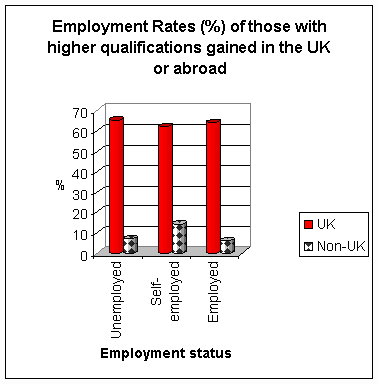
|
|
4.0 TRAINING
|
|
4.1
Past/Present training analysis
|
|
The unemployed respondents gave the survey an
indication of the source of training they had in the past.
|
|
The largest number of unemployed respondents
(53%) indicated that they only had 'on the job' training. This indicates nothing
of their present situation, however the large number does indicate a problem
with their training in prior positions of employment.
|
|
Chart 8: Source of Training for the unemployed
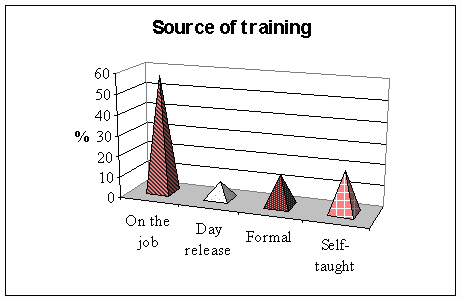
|
|
Only 12% of self employed respondents provided training
within their business for employees. As illustrated below.
|
|

Chart 9: Respondents who
provide training within their business for employees.
|
|
The net effect for employers could be a poorly skilled
workforce, which in turn could be limiting too profits.
The net effect for employees could be low morale, lack of
motivation and a desire to work within another organisation.
The vast majority of employed respondents only had training
in their present position, in most cases the employer would have the
responsibility of organising in house training.
As most of the employed staff are employed in family
businesses, training could be seen as not a major priority amongst the business
owners.
|
|
4.2 Future training desires
|
|
A considerable number of respondents (55%) also expressed a
wish to become self-employed, take up training and free advice in the future.
48% of the total sample indicated their desire to attend
further training courses in the future.
Of those expressing a desire for further training 38% were
employed and 39% were unemployed.
The charts below represents the level of interest in courses
that ENTRUST can provide.
40% of all respondents were interested in IT and a
further 36% were interested in raising money/finance.
Table 2 below is only a random selection of other courses
respondents expressed an interest in. The varied interest of the respondents
seems to indicate a high interest in further learning/training.
|
|
Table2: Other courses interested in
|
|
Other courses respondents are interested in |
|
Fashion |
|
Communications |
|
Asset Technical Service |
|
Law |
|
Taxes |
|
Photography |
|
Buying |
|
2 English |
|
Postgraduate |
|
Chart 10: Courses that respondents were interested in, in
relation to their employment status
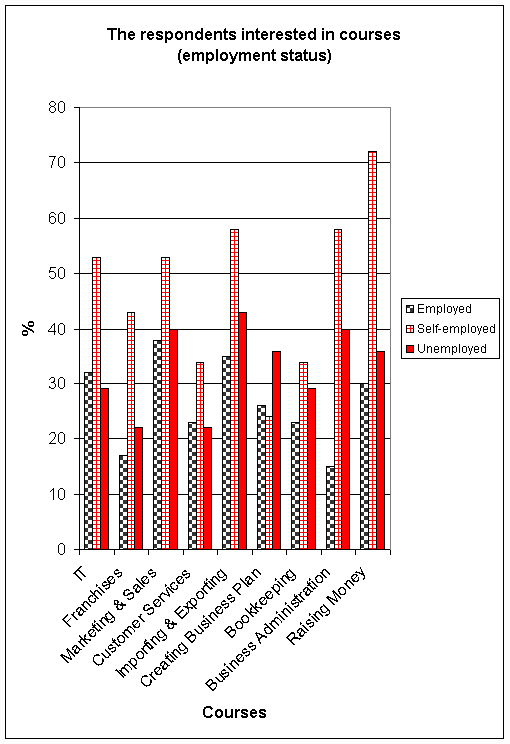
|
|
All respondents from the
sample chose more than one training course that they would be interested in. A
high interest for courses by employment sector is depicted above.
|
|
4.3 Analysis of interest in courses
|
|
This analysis raises certain points:
Firstly, why are there such a high number of unemployed
respondents who desire further training, it is obvious this would improve their
employment potential meaning that such facilities have not been easily
accessible, prior to the audit. Could this be a reflection of low morale and
motivation of the unemployed within this community?
Secondly, a significant proportion (38%) desired further
training even though they were currently employed. This could be seen as a
combination of trying to enhance their personal skills and career prospects or
it could be an expression of dissatisfaction with their current employment.
|
|
4.4 Perceived barriers to training
|
|
The survey examined the perceived barriers to training;
respondents could list more than one barrier.
The respondents were widely spread but a significant number
(25%) stated they had no free time, However most of the respondents who
contributed to this figure also stated unsuitable times of courses prevented
them from attending as well as a lack of money to finance the training.
The pattern of perceived barriers for women were very
different with family commitments being high on the table of business.
|
|
Chart 11: Factors preventing respondents from attending
training courses.
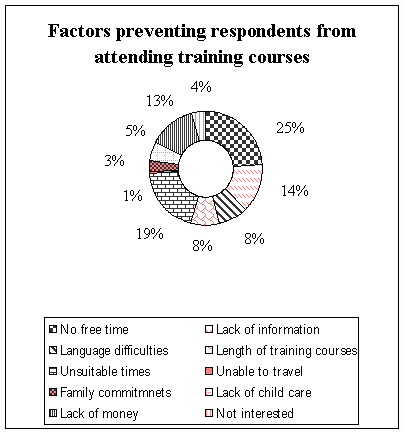
|
|
5.0 Chapter 6 EMPLOYMENT
|
|
5.1 Contributory Factors
|
|
A significant number 79% of respondents held driving licences.
Considering the above and the good transport network in Newcastle upon Tyne,
access is not likely to be a significant barrier to those seeking employment.
|
|
5.1.1 Profile of employment
|
|
40 % of all respondents were in employment as illustrated in
Chart 12, below:

Chart 12: Profile of
employment
|
|
None of the respondents were disabled.
A significant number (40%) of employed respondents worked
within the Grainger Town Area. As can be seen on Chart 13, below.
The predominant percentages (39%) of employees worked for the
employers were the small sized organisation with 1 to 9 employees. This is illustrated in chart 16, on the
following page.
|
|
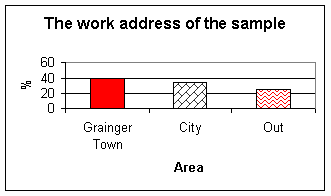
Chart 13: The work address of the sample
|
|

Chart 14: The percentages of
employees working within respondent's workplaces.
|
|
5.2 Sources of seeking employment
|
|

A popular
method of gaining employment within the Chinese community appears to be by
approaching the employer directly (40%) or being approached by the employer
(23%). As illustrated below:
Chart 15: Main method used by employed respondents to find
current job.
|
|
The above chart appears to indicate an informal method of
gaining employment within the community. In comparison only 3% obtained
employment via a job centre and 8% by newspaper, advertisement which is the norm
amongst other communities.
Knowledge of careers offices and job centres is invaluable,
not only to the unemployed but also to the employed as if respondents wish to
target employment and training initiatives.
Given the high level of English speakers amongst the sample,
it is surprising that the main source of finding work is through personal
relationships between employee and employer.
|
|
5.3 Job Title
|
|
Although represented in all types of employment, there has
previously been a disportionate concentration of Chinese people working within
the catering industry.
The reasons for this is considered to be the boom in that
particular industry, within Newcastle upon Tyne in the early Sixties, and that
Chinese people often prefer to work with other employees of similar origin for a
variety of reasons including cultural, language and financial.
Workers are involved in a wide range of occupational
categories with skilled and semi-skilled occupations appearing throughout.
|
|
Chart 16: Employed respondents allocated job titles.

|
|
However a significant number of respondents were employed in
what is described as a low occupational category e.g. Shop Assistant or Waiter.
|
|

Chart 17: Employed respondent's current employment
organisation.
|
|
5.4 Employment organisation
|
|
An analysis of the job title and the types of industry
sectors reinforced the previous statement that a considerable number of
respondents were concentrated in the industry of catering.
Although there is no survey evidence to substantiate this
view, it is considered that this lack of movement into different employment
areas could cause extensive damage if the catering industry were to have a down
turn.
|
|
5.6 Future Employment Aspirations
|
|
The majority of respondents 59% who were employed at the time
of the survey considered that their present job matched their personal skills
and training. However, the analysis of the skills and education of respondents
would disagree with this as analysis of individual skills in relation to current
employment in section 8, provides evidence that a considerable number of
respondents were underemployed.
Even more symbolic was that 32% of respondents were looking
for a new position of employment.
'Not the first career choice' was considered to be the major
factor for wanting a new job.
The lack of career satisfaction will be discussed in more
depth in chapter 8.
|
|
6.0 Chapter 6 UNEMPLOYED
|
|
The unemployment level amongst the survey was 34% of the
total number surveyed.
The largest proportion (40%) of those unemployed had been out
of work for a considerable period of time, over 12 months. This is illustrated
in the chart below.
|
|
Chart 18: Time out of work
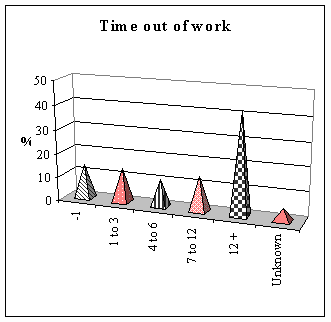
|
|
Note: (Long term unemployment is normally a term that
categorises those who have been out of work for a year or more.)
Often the longer the period of time the person is out of
work, the less choices of re-entering employment.
The experience of job loss is itself a demoralising factor,
whilst the long-term unemployed are generally viewed less favourably by an
employer who is offered a choice.
The long term unemployed are therefore stuck in a self
perpetuating cycle of being unable to obtain work, potentially, as a result of
having been out of work for a long time.
|
|
6.1 Categories of unemployment
|
|
Further analysis of the unemployed revealed surprising
results in terms of the categories of unemployment.
A considerable number of those unemployed (50%) were not
claiming benefit of any kind.
Although there is no specific evidence, it appears that the
Chinese community are less likely to have been registered unemployed for what
could be a multitude of reasons e.g. Personal, financial, confidential etc.. One
positive aspect of unemployment is the time available to further their
education, increasing the chances of employment.
The unemployed have a number of varied responses to the
reason behind their unemployment, significantly 60% preferred to give their
reason as personal.
It should be noted that a high proportion (15%) had entered
higher education and had not gained employment once finished.
|
|
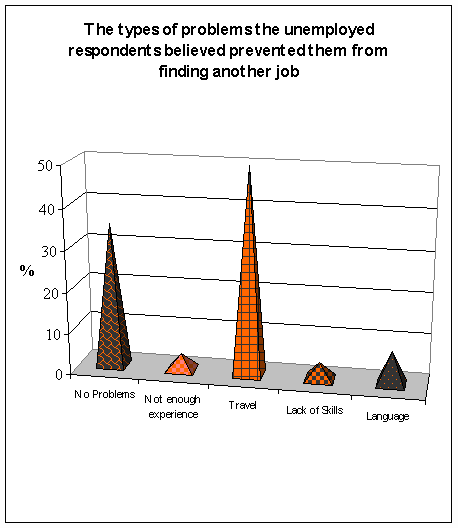
Chart 19: The types of
problems encountered by the unemployed.
|
|
Not all the respondents felt that their language had
prevented them from obtaining a job, contrary to popular belief.
When asked what factors prevented them from getting work,
respondents (48%) highlighted travel as their main problem. This could have
indicated a severe problem with transport, but as previously outlined, travel
throughout the North-East is good, however the cost is quite high and this could
be a factor.
The assumption can be made that those truly seeking work
would consider travelling anywhere in the City and outside areas.
33% also stated they had no problems, which is somewhat
alarming as it could be contrived as there being no reason they would not enter
employment.
|
|
6.2 Past Employment
|
|
The unemployed respondents had worked within a vast range of
job categories.
It should be noted however that most of the jobs previously
held, were in the catering industry or of a low occupational category.
However there were exceptions with highly skilled
'white collar' jobs previously held by the unemployed such as nursing and graphic
designing.
|
|
6.3 The Future for the Unemployed Respondents
|
|
6.3.1 Future Employment
|
|
The unemployed respondents were also asked what level of work
status they would wish to enter and the types of careers they would enter into.
The majority of individuals (42%) indicated that they would
like to be in full time employment.
The respondents mostly chose careers in which they had not
previously been employed. However, there were exceptions with a number of
respondents choosing waiter/essing in which they had previously been employed
in. Those respondents that choose this path normally had other skills, which
they seemed to overlook, further discussions will appear in section 8.
|
7.0 Chapter 7 Self-employed
7.1 Profile
|
The survey encompassed 25% of
all respondents who were
self-employed.
The most common business areas in the present survey were the
food, restaurant industry with 17%. This is illustrated in the graph below which
also highlights other business areas.
|
Chart 20: The type of business
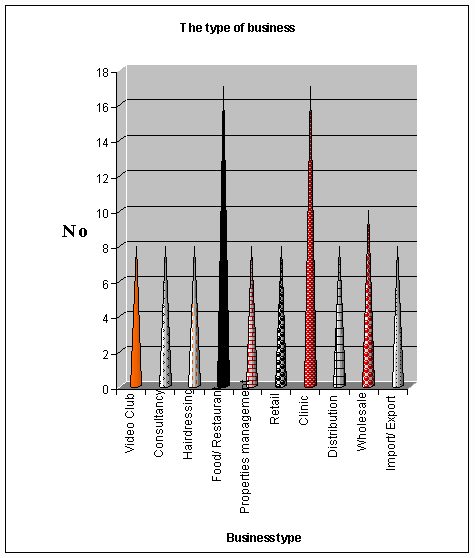
7.2 Time in Business
|
The majority of self employed (25%) had been in operation for
over 10 years or more, and had always been self employed (51%)
As illustrated, below:
|
Chart 21: Time in Business
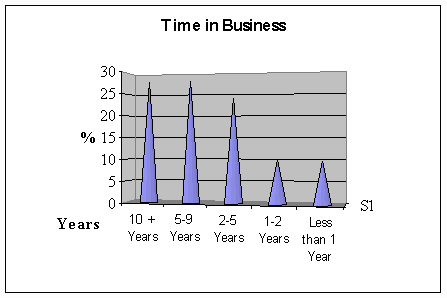
|
The other significant elements to consider were the majority
of respondents (48%) had a family owned business. This is not remarkable as
illustrated in section 6, employed respondents were employed in family
businesses, which appears to be the norm amongst the sample.
The survey suggests that self-employed respondents involved
family members in the running of their business and in the finance of the start
of their business.
The size of the 'self-employed' businesses in terms of
employees, ranges from 1 employee to over 50. The majority of businesses (80%)
employed 1 to 5 employees.
This is of particular relevance to ENTRUST has we provide
assistance to SMEs in the area.
|
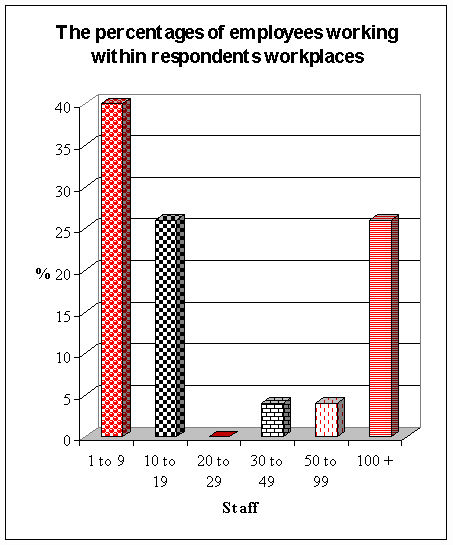
Chart 22: Size of Business
7.3 The self-employed business status of respondents.
The majority of the sample were sole traders (55%) however a
significant number (25%) were partnership companies. As illustrated below.
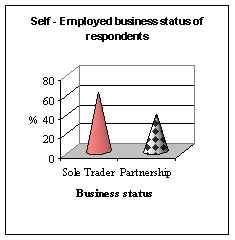
Chart 23: Self employed
business status of respondents
7.4 Source of Assistance
|
The main sources of assistance used in setting up the
business encompassed within the present survey are illustrated below.
|
Chart 25: The sources of assistance used in setting up in
business.

|
In light of the above chart, the bank (33%) which is a normal
?port of call?, is still used by respondents to set up in business. However a
significant number, (27%) also encompassed friends and family.
Reinforcing a popular belief that the community is ?close
knit? and where ever possible, prefers to help one another set up in business.
A downside of assistance from family members could be a
contribution towards problems in terms of expansion, if the family unit lacked
sources of funding the business could suffer. Arguments within families could
cause legal problems and generally, differences could limit businesses
'development potential'.
|
7.5 Business aspirations
|
The survey indicated a high level of business aspirations
within the Chinese community. All of the self-employed respondents stated that
they have considered improving their business in one way or another.
A few suggestions they gave are contained within the table
below:
|
Table 3: Business aspirations
|
Business Aspirations |
|
|
|
Increase takings |
|
Expand |
|
Branch out |
|
Increase products |
|
Open Franchise |
|
New markets |

Chart 24: Self employed respondent?s opinions to setting
up a new venture.
|
As illustrated in the chart above a further 49% of
respondents also stated they would consider setting up a different kind of
business. This could be a way in which those that have concentrated on the
catering industry could branch out into other areas of business.
The type of business run by the group has so far seemingly
not been adversely affected by a downturn in the economy. As mentioned
previously however the opportunity for small businesses in the Grainger Town
area is very limited in terms of expansion. Thus, the scope to employ family
members and acquaintances becomes limited.
|
8.0 Chapter 8 Skills
|
This chapter, entitled Skills, is an analysis of whether
there is a true match between the present employment status of respondents and
the skills they have/or perceive themselves to have gained.
It has not been possible for reasons of confidentiality and
time, to analyse every respondents skills in relation to employment. However,
overall skills of respondents in their employment sectors have been analysed,
with a small number of respondent's skill profiles highlighted as examples.
What follows is a breakdown that indicates unambiguously,
that a number of the respondents were under employed.
|
8.1. Employed
8.1.1 Present employment
|
The employed respondents, like most other respondents in the
audit, were highly skilled in a number of mediums. As the table below
illustrates, the employed respondents had gained a variety of skills in their
present type of employment. The skills were by no means trivial, Customer Care,
Administration and Teaching to name but a few. However, as discussed in previous
chapters, some of the employed respondents did not have a high job category and
a great number( %) wanted further training to improve their job prospects. This
could signify a high level of Under employment.
|
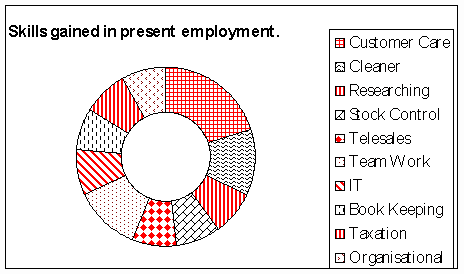
Chart 25: Skills gained in
present employment employment
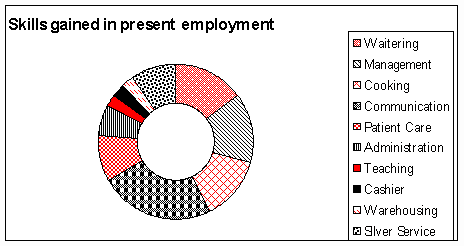
Chart 26: Skills gained in
present employment continued
|
The table above further illustrates the wide range of skills
the respondents believe they had collected in their present position of
employment.
The table below illustrates the methods used by respondents
to gain their skills. Respondents were able to choose more than one method.
Only 19% of the skills respondents recorded were formal
qualifications, the most significant section had on the job training. This is
not any less relevant to employment, and should be looked upon as more
significant in terms of employment experience. A greater number of organisations
now require formal qualifications as well as experience.
|
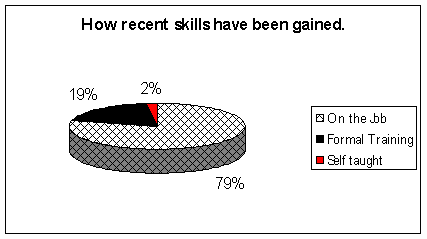
Chart
27: How recent skills have been gained
8.1.2 Past Employment
|
The respondents also recorded the skills they had gathered in
their prior positions of employment. This enabled a further analysis of the
skills they had in relation to their current position of employment. As the
table suggests the respondents had a lot more skills than they had gathered in
their present employment. These skills could be used to improve their employment
level.
The table below illustrates a random selection of the skills
gained in prior employment.
|
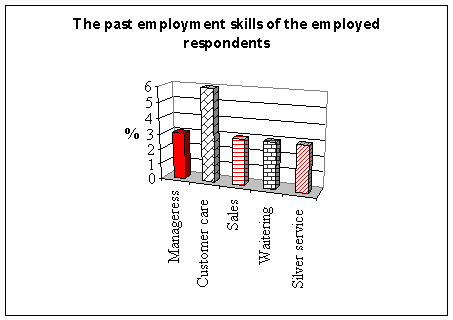
Chart 28: The past employment skills gained
|
The skills that respondents had gained in the past were
through formal training. This appears to be the norm amongst the sample. The
table on the next page illustrates this.
|
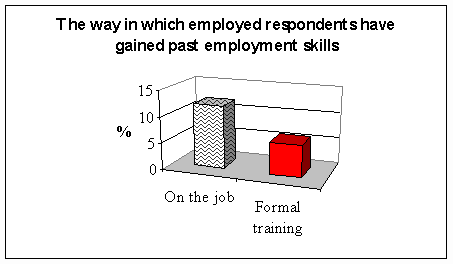
Chart 29: The way in which
employed respondents have gained past employment skills
Past Employment Organisations
|
The respondents also told the survey the past employment
organisations that they worked in, this was extremely useful as we could
establish a pattern of under employment on a longer basis.
The table below is a selection of past organisations that
respondents worked within.
|

|
The chart above (Chart 30) shows a high proportion of
employment within catering in previous positions. This is not surprising as most
of the employed respondents are employed within the catering industry.
What is surprising, is the other skills employed
respondents had. Respondents were asked to discuss skills, which they perceived
they had. This did not necessarily have to be employment skills.
The responses to this question were quite alarming and
confirmed earlier suspicions of under employment. As illustrated by the sample
of skills on the next page a considerable number of the sample were highly
skilled in other areas. In relation to their current employment some of their
skills outweighed their current employment position.
The next page contains the chart (chart 31) of a selection of
Other skills.
|
Chart 31
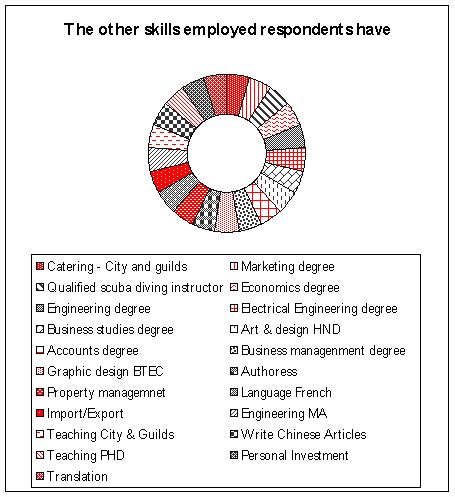
|
The above table represents only a fraction of the skills
respondents have. As the chart illustrates, with examples of Accounts degrees
and Teaching and PhDs, the sample is highly qualified in other areas of
employment.
In the examples featured in 2.6, Section 8, Skills a random
selection of respondents were discussed to represent the sample as a whole. This
is not ideal for a true representation of the employed respondents. It would
have been better to analyse the whole sample but this was not possible for a
number of reasons, most notably time and confidentiality.
|
8.2. Past employment skills
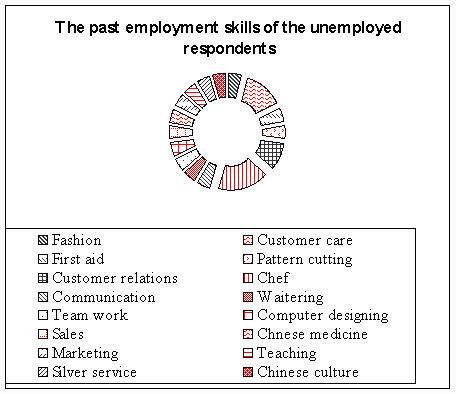
The chart above (chart 32)
is a selection of responses to the question of 'what skills they gained from
previous employment'.
|
The chart on the previous page is similar to the responses of
the employed respondents in that it shows the unemployed have skills in numerous
areas such as Marketing and Customer care.
|

Chart 33
|
Again the skills that the respondents choose to highlight
were mainly on the job training as illustrated above.
Additionally the other skills showed a high level of
different skills that could hopefully establish an unemployed person in either
employment or in the position of being able to train or start up a business.
As previously illustrated in the employed section of this
chapter examples of respondents who have not attained their personal levels of
employment are described in 2.6, Section 8, skills
|
8.3 Self employed respondents
|
The self employed respondents much in the same way as the
unemployed respondents, can not really be analysed under 'employment'. A number
of self employed respondents did however want to start new businesses and what
would be useful is to understand the extent of skills they already have, in
order to provide training and business advice.
|
8.3.1 Present Employment Skills
|
The self-employed respondents all said they had at least one
skill that they used in their business/es. Only a couple of respondents
mentioned skills that they may not have used in business e.g. Chinese
Medicine
|
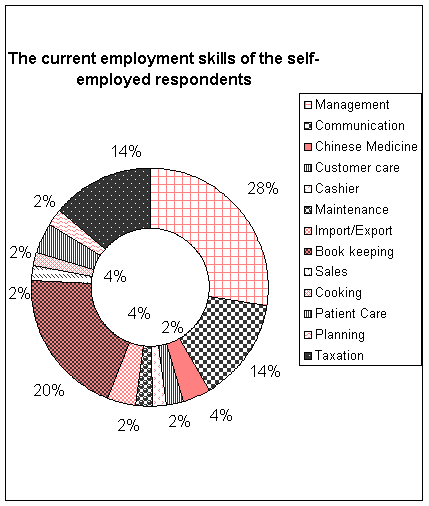
Chart 34
|
The self-employed respondents, just like the previous
respondents, also stated the way in which skills were gained. It follows the
same pattern as previously. Current skills were normally learnt on the job. The
table below illustrates this. (Chart 35).
|
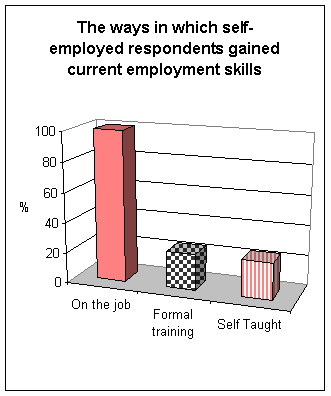
8.3.2 The Past Employment skills
|
The self-employed respondents also gave examples of past
employment skills that they had learnt in previous employment as illustrated in
the table on the next page. Most of the respondents felt that they had good
communication skills and Customer Relations Skills.
|

Chart 36
|
The self-employed respondents, like most of the respondents,
had gained there past employment skills from on the job training.
|
Chart 37

|
The other skills that respondents mentioned are of vital importance in being
able to diagnose what self-employed respondents would require. If respondents
have other skills that could be developed into a new business and have thus far
been unable to use them than this could be termed under employment in business.
The table that follows is the
other skills that
self-employed respondents have.
|

Chart 38
|
The skills respondents have are extremely diverse with skills
ranging from language skills to graphic design.
|
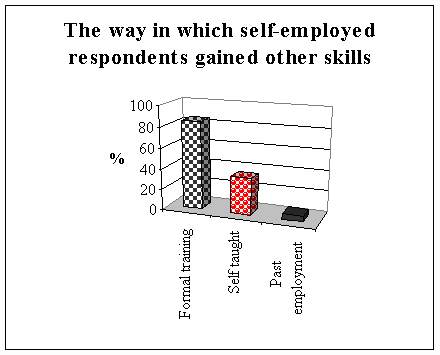
chart 39
|
The other skills were learnt in a number of ways as before
but most of the respondents have formal training in the areas that they choose
to acknowledge. This is promising for future developments of businesses.
|
9.0 Chapter 9 Business Aspirations of
All Respondents
9.1
Businesses
|
The survey indicated a high level of business aspirations
within the sample as a whole, 53% of all respondents stated that they would
like to set up their own business.
It has been considered that the possibility of social
mobility through self employment may be seen as greater than that available as
an employee and some may consider the risk of self employment to be preferable
to the despair of unemployment.
The pattern of interest is as follows:
|
Table 4
|
The types of desired businesses |
Printing |
|
|
Gifts |
|
Post office |
Car services |
|
Media Buying agency |
Chinese Culture Centre |
|
No ideas |
Wedding Centre |
|
Restaurant |
Aromatherapy |
|
Leisure/ Brewery |
Design company |
|
Underwear |
Alternative health care |
|
Import/ Export |
Hunting club |
|
PR company |
Web site design |
|
Freelance training |
Bookkeeping |
|
Chinese wine bar |
IT |
|
Chinese Articles |
Properties |
|
Chinese fortune teller |
Sub contracting |
|
Travel services |
Illustrator |
|
Scuba Diving |
|
The suggested businesses, in more ways than one, mirrored the
skills and training respondents mentioned in the survey. Other suggestions of
businesses were taken from hobbies or interests that the respondents enjoyed and
believed could be turned into a business idea.
The hobbies of interests respondents believed they could turn
into a business.
|
Table 5
|
Scuba diving |
DIY |
|
Cars |
Chinese art & craft |
|
Designing surface patterns |
Party |
|
Design skills |
Design |
|
Computing IT |
Translation |
|
Connections with china |
Hunting |
|
Driving instruction |
Catering skills |
|
Aerobics |
Chinese medicine |
|
Organising party functions |
9.2 The barriers preventing respondents from setting up in
business
|
The respondents gave various responses to what prevented then
from setting up in business. The largest barrier that has to be overcome is the
lack of funding; also a significant percentage (18%) would require business
advice to start up a business.
|
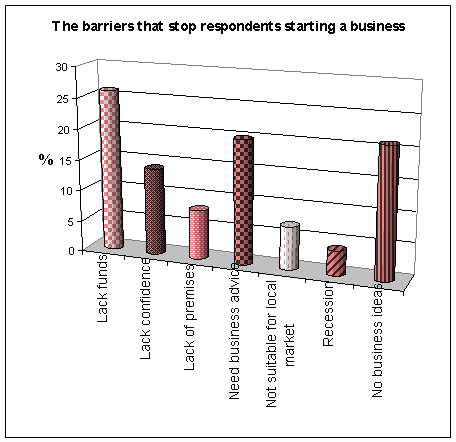
Chart: 39
|
42% of respondents want further contact about a business
idea, which establishes a need for further contact.
5% of respondents knew someone who was seeking a job,
training or looking to set up in business.
|
Chart: 40
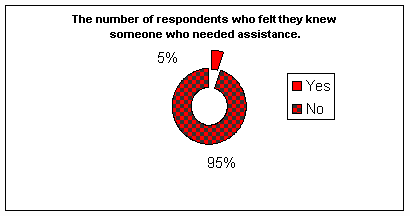
Appendices Contents
|
1 The map of the Grainger Town area of Newcastle upon Tyne
2 A description of ENTRUST
3 An example of the Grainger Town Partnership: Community
Skills Audit
|
 1
Map of the Grainger Town Area 1
Map of the Grainger Town Area
2 ENTRUST
|
ENTRUST is an
Enterprise Agency, which was established in 1981 by the Tyne & Wear County
Council. It is a company limited by guarantee and is a non- profit-making
organisation.
ENTRUST has now been operating for 16 years offering business
advice, counselling and training to start-up business and establish SMEs. During
this period we have established reputation for effective delivery of our
services. As a service provider we place great emphasis on the quality and have
gained ISO 9000. All counsellors and trainers who are either full-time employees
are required to acquire appropriate professional accreditations. All counsellors
and consultants are required to attend our courses for Continuing Professional
Development.
In addition to the work we undertake with the wider SME
Community we have developed specialist areas of expertise. We have developed
with developed with working with local ethnic communities through City
Challenge, The racial Equality Council etc.
|
Grainger Town Partnership Programme: Community Skills Audit
|
Reference Number: |
Serial Number: |
|
Interviewer:
|
Start Time/ End Time: |
|
Location of Interview: |
Date: |
|
As Part of the Grainger Town Partnership Programme,
this development scheme has been set up to encourage enterprising individuals to
set up businesses within the Grainger Town area. This special scheme is aimed at
the Chinese Community, particularly the second generation and the underemployed,
to encourage and develop new business enterprises. It seeks to provide training,
skills and assistance to those who may have a business idea but have found it
difficult to get started either through lack of support or knowledge of what
help is available
We are conducting an audit to assess the needs and
aspirations of the community, which has so far concentrated on catering. The
emphasis will be the encouragement of diversification into non-traditional
areas.
Please help us to help you.
All answers are treated confidentially.
Please answer all the questions applicable to you, but feel
free to ignore questions that you are uncomfortable with.
|
DATA PROTECTION ACT 1984
|
The information held by the Grainger Town Partnership
Programme may be used to contact you, either in writing or by telephone.
Under the Data Protection Act 1984, you are entitled to a
copy of your personal data held by us on computer.
Please sign below if you do not object to having your details
on a computer database.
If you do not wish us to send you information about services
from the Grainger Town Programme, please tick this box.
|
|
Signature: |
Date:
|
|
Name (Block Capitals)
|
Section A - Personal Information
|
Title
|
Mr |
Mrs |
Miss |
Ms |
Dr |
|
First Name
|
|
|
Last Name
|
|
|
Address |
|
GT |
|
City |
|
Out |
|
City
|
|
|
Post Code
|
|
|
Telephone
|
|
|
Sex
|
Male |
Female |
|
|
Martial Status
|
Single |
Married |
Separated |
Divorced |
Widowed |
|
Date of Birth
|
Day |
Month |
Year
19__ __
|
|
|
Age Range
|
16-25 |
26-35 |
36-45 |
46+ |
|
|
Place of Birth
|
UK |
HK |
China |
SE Asia |
Elsewhere |
|
If you were not born in UK, how long have you have
resided in UK?
|
Less than 12 months |
1 to 2 years |
2 to 5 years |
5 to 10 years |
Over 10 years |
|
Full Driving License? |
Yes |
No |
|
|
Do you have access to a car? |
Yes |
No |
|
|
Do you have any disabilities? |
Yes |
No |
|
| |
|
|
|
|
What is your current situation? |
Employed
|
Go to Section B |
|
Self-employed
|
Go to Section C |
|
Unemployed
|
Go to Section D |
Section B - Employed
|
Your job status
|
Full time |
Part-time |
Temporary |
|
How did you find your current job |
Family business |
Job Centre |
|
Approached employer directly |
Careers office |
|
Approached by the employer |
Job club |
|
Newspaper |
|
|
Name of Employer
|
|
|
Address of Employer
|
|
GT |
|
City |
|
Out |
|
Job title
|
|
|
Job Function
|
|
|
Length of service with employer |
< 1 year |
1 to 2 years |
2 to 5 years |
5+ years |
|
Type of organisations/business |
Restaurant |
Takeaway |
|
Wholesale (cash & carry) |
Manufacturing |
|
Retail (shops) |
Bank/Building society |
|
Local government |
Financial Services |
|
Import/export |
Printing |
|
Professional (Solicitors, Accountants) |
IT/computers |
|
Medical (Doctors/ Hospitals) |
|
|
If none of the above, please state:
|
|
|
Number of employees |
1 to 9 |
10 to 19 |
20 to 29 |
|
30 to 49 |
50 to 99 |
100+ |
|
Do you think your present job matches your skills and
training? |
Yes |
No |
|
|
Have you always had the same job? |
Yes |
No |
|
|
Are you looking for a different job at present? |
Yes |
No |
|
|
|
If yes, why is this?
|
|
|
|
And, what kind of job are you seeking?
|
|
Now please go to section E
Section C- Self-employed
|
Business status
|
Sole trader |
Partnership |
|
Have you always been self-employed? |
Yes |
No |
|
Is it a family business? |
Yes |
No |
|
Type of business
|
|
|
How long have you been business
|
Less than 1 year |
5 to 9 year |
|
1 to 2 years |
10+ years |
|
2 to 5 years |
|
|
Number of employees?
|
None |
11 to 20 |
|
1 to 5 |
20 to 50 |
|
6 to 10 |
50+ |
|
Address of business
|
|
GT |
|
City |
|
Out |
|
Who did you approach when you were setting up the
business?
|
Bank |
Local Authority: |
|
Accountant |
Family and friends |
|
Solicitor |
Business Link |
|
Other
|
|
Do you provide training in your business? |
Yes |
No |
|
|
What are your future objectives for your business?
|
|
Now please go to section E
Section D- Unemployed
|
Which statement describes your situation
|
Unemployed and claiming benefit |
|
|
Unemployed and NOT claiming benefit |
|
|
In between jobs |
|
| |
|
|
Length of unemployment |
< 1 month |
7 to 12 months |
|
1 to 3 months |
12 + months |
|
4 to 6 months |
|
|
What kind of job(s) are you seeking
|
|
|
Work status |
Full time |
Home working |
|
Part time |
|
|
What kind of jobs have you had in the past?
|
None
|
|
| |
|
|
Why did you leave your last job? |
Redundancy |
Health reasons |
|
Temporary job ended |
Personal reasons |
|
Other |
|
What skills did you gain when you were working?
|
None |
|
|
How did you gain these skills? |
On the job |
Day release at college |
|
Formal training |
Self-taught |
|
Have you encountered any particular problems whilst
seeking employment? |
|
Now please go to section E
Section E - Education and Training
|
Please indicate level of education and qualifications:
(Please tick where appropriate) |
UK |
HK |
China |
SE Asia |
Elsewhere
(Please fill in where?) |
|
O-level/CSE/GSCE |
|
|
|
|
|
|
A-level |
|
|
|
|
|
|
Degree (BA, BSc) |
|
|
|
|
|
|
Postgraduate (MA, PhD, MBA) |
|
|
|
|
|
|
City & Guilds |
|
|
|
|
|
|
BTEC |
|
|
|
|
|
|
HNC/HND |
|
|
|
|
|
|
Professional (ACCA) |
|
|
|
|
|
|
Other:
|
|
|
Would you be interested in any of the following
training courses?
(Tick any that are appropriate) |
Information Technology |
|
|
Creating a Business Plan (accounts \ research) |
|
|
Franchises |
|
|
Book keeping |
|
|
Marketing and Sales |
|
|
Business Administration |
|
|
Customer Services |
|
|
Raising Money |
|
|
Importing and Exporting |
|
|
What other courses would you be interested in?
|
|
|
Are there any factors preventing you from taking a
training course?
(Tick any that are appropriate) |
Present job does not allow enough free time |
|
|
Lack of information about what is available |
|
|
Language difficulties |
|
|
Length of training courses |
|
|
Training courses are at unsuitable times |
|
|
Unable to travel to the training course |
|
|
Family commitments |
|
|
Lack of child care facilities |
|
|
Lack of money for certain course fees |
|
|
Not interested in the courses available |
|
Now please go to section F
Section F-Starting up
|
Would you consider setting up your own business? |
If you are self-employed, would you considering setting
up a different kind of business?
|
|
Yes |
No |
Yes |
No |
|
If yes,
what kind of business?
|
|
|
If no, what
has stopped you getting this business started? |
Lack funds |
|
|
Lack of confidence |
|
|
Lack of premises |
|
|
Need business advice |
|
|
Not suitable for local market |
|
|
Recession |
|
|
Have no business idea |
|
|
Do you have an interest or hobby that may be developed
into a business idea? |
Yes (If Yes, please state) |
No |
|
Would you take up free advice, training and finance to
set up a business? |
Yes
|
No |
|
Do you know anyone who is seeking a job or training or
looking to set up their own business in the Grainger Town area: |
Yes
Name & Telephone:
|
No |
|
Would you like someone to contact you about a business
idea that you have? |
Yes
|
No |
Section G-Detail of Personal Skills and Qualifications
Achieved
(This section is an extension of previous sections)
Current Employment (please tick the appropriate section)
|
Type of organisation/business |
Restaurant |
Takeaway |
|
Wholesale (cash & carry) |
Manufacturing |
|
Retail (shops) |
Bank/Building society |
|
Local government |
Financial Services |
|
Import/export |
Printing |
|
Professional (Solicitors, Accountants) |
IT/computers |
|
Medical (Doctors/ Hospitals) |
Others please state |
|
What skills did you gain at this present employment?
|
None |
|
|
How did you gain these skills? |
On the job |
Day release at college
|
|
Formal training
|
Self-taught |
Past Employment (please tick the appropriate section)
|
Type of organisation/business |
Restaurant |
Takeaway |
|
Wholesale (cash & carry) |
Manufacturing |
|
Retail (shops) |
Bank/Building society |
|
Local government |
Financial Services |
|
Import/export |
Printing |
|
Professional (Solicitors, Accountants) |
IT/computers |
|
Medical (Doctors/ Hospitals) |
Others please state |
|
What skills did you gain at the past employment?
|
None |
|
|
How did you gain these skills? |
On the job |
Day release at college
|
|
Formal training
|
Self-taught |
Other forms of skills (personal and educational)
|
What other skills do you have?
|
None |
|
|
How did you gain these skills? |
Past on by family |
Self-taught
|
|
Formal training
|
Others please state |
Thank you very much for you co-operation
|